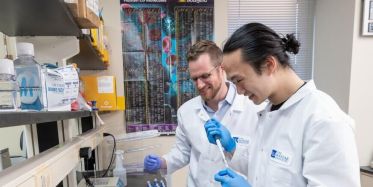Daniel Claiborne, Ph.D.
-
Assistant Professor, HIV Cure and Viral Diseases Center
-
Vaccine & Immunotherapy Center
-
Genome Regulation and Cell Signaling Program, Ellen and Ronald Caplan Cancer Center
-
Scientific Director, Histotechnology Facility
Claiborne is an immunologist focused on understanding how the function of T cells is modulated to create improved immunotherapies, including CAR T cell therapies, against HIV.
Claiborne earned his B.S. in Biochemistry from Florida State University and a Ph.D. in Immunology and Molecular Pathogenesis from Emory University. He completed his postdoctoral training at the Ragon Institute of MGH, MIT, and Harvard and joined The Wistar Institute in 2021 as a Caspar Wistar Fellow.
The Claiborne Laboratory

The Claiborne Laboratory
T cell immunotherapies offer hope for the treatment of malignancies and other chronic diseases. However, natural mechanisms in place to limit immune-mediated pathology ultimately attenuate the T cell response in the setting of chronic antigen exposure, such as is found in chronic viral diseases – including HIV – as well as cancer. A better understanding of the mechanisms underlying T cell exhaustion has the potential to revolutionize T cell immunotherapies, such as chimeric antigen receptor (CAR) T cell therapy, for the treatment of human disease.
The Claiborne lab is rooted in understanding the complex interplay between the virus and the host in HIV transmission, pathogenesis, and persistence. A central focus of the lab is the optimization of CAR T cell therapy for a functional HIV cure. Concordant with efforts to engineer potent CAR T cell therapies against HIV, the Claiborne lab seeks to uncover the mechanisms behind the initiation and maintenance of dysfunctional T cell phenotypes, as the pursuit of these questions is critical to developing the next generation of T cell immunotherapies. To answer these complex questions, the lab leverages the powerful in vivo model system of HIV-infected humanized mice coupled with HIV-directed CAR T cells to study the evolution of antigen-specific T cell function over time.
-
Research Assistants
Gabriel Finnell
-
Graduate Students
Reyes Acosta (UPenn-CAMB)
Federica Severi (UniBO) -
Postdoctoral Fellows
Francesco Pennino, Ph.D.
Nur Izzah Binti Ismail, Ph.D.
Research
MAPPING THE ONTOGENY OF DYSFUNCTIONAL CAR T CELL PHENOTYPES
Progressive T cell exhaustion and dysfunction due to continuous antigen exposure is a hallmark of chronic viral infections. In situations of uncontrolled HIV replication, we have observed a striking and progressive increase in the co-expression of multiple inhibitory receptors on CAR T cells in humanized mice. Additionally, CAR T cells isolated from viremic humanized mice display attenuated effector function ex vivo when compared to the transferred T cell product at baseline. Using this model system, and through a combination of transcriptomics and ex vivo functional assays, the Claiborne lab intends to map the initiation and maintenance of dysfunctional T cell subsets in an effort to uncover gene pathways/programs that can be targeted to prevent or reverse T cell exhaustion – with the goal of engineering more potent CAR T cell immunotherapies.
MAPPING THE KINETICS, CO-EXPRESSION, AND PLASTICITY OF INHIBITORY RECEPTOR EXPRESSION IN CHRONICALLY STIMULATED CAR T CELLS
We have recently developed a novel in vitro model system for chronic antigen stimulation of CAR T cells with the ability to specifically titrate antigen dosing as well as remove antigen stimulation at any time. Using this unique model system, we have mapped the longitudinal and concomitant expression of multiple inhibitory receptors on human CD4 and CD8 CAR T cells. We further aim to understand the functional consequences of multiple inhibitory receptor expression, whether periods of rest due to antigen removal can reverse certain inhibitory receptor profiles, and which profiles are indicative of long-term transcriptional reprogramming.
INFLUENCE OF VIRAL CHARACTERISTICS ON HIV-SPECIFIC T CELL FUNCTION
Previous work by the lab has demonstrated that the intrinsic viral replicative capacity (vRC) of the transmitted/founder virus can greatly impact the disease course of HIV-infected individuals. Individuals infected with high-vRC variants display exacerbated immunopathology characterized by T cell activation and exhaustion, concomitant with rapid CD4+ T cell loss. This may also represent an unrecognized hurdle for a functional HIV cure, as individuals with high-vRC viruses may be more refractory to CAR T cell therapy or other interventions. The lab endeavors to use a previously generated suite of chimeric viruses exhibiting distinct vRC phenotypes to define the extent to which vRC affects CAR T efficacy in vitro and in vivo and to elucidate the mechanisms responsible.
ROLE OF THE INNATE IMMUNE SYSTEM IN MODULATING CAR T CELL FUNCTION
Recent evidence in a humanized mouse model of acute lymphoblastic leukemia demonstrates that interactions between CAR T cells and the innate immune system can enhance CAR T cell function but can also contribute to cytokine release syndrome (Norelli M et al., Nature Medicine, 2018). During HIV infection, vigorous innate immune responses ultimately contribute to chronic immune activation and inflammation, which is associated with accelerated pathogenesis. These data suggest a complex role for components of the innate immune system, with the potential for enhancing or attenuating functions, in modulating CAR T cell efficacy in the context of HIV infection. We have created a series of reagents to specifically ablate or enhance monocyte function in humanized mice and endeavor to use this in vivo system to elucidate the role of the innate immune system in affecting HIV-specific CAR T cell function.
Claiborne Lab in the News
Selected Publications
Dual CD4-based CAR T Cells With Distinct Costimulatory Domains Mitigate HIV Pathogenesis In Vivo.
Maldini, C.R., Claiborne, D.T., Okawa, K., Chen, T., Dopkin, D.L., Shan, X., Power, K.A, Trifonova, R.T., Krupp, K., Phelps, M., et al. “Dual CD4-based CAR T Cells With Distinct Costimulatory Domains Mitigate HIV Pathogenesis In Vivo.” Nat Med. 2020 Nov;26(11):1776-1787. doi: 10.1038/s41591-020-1039-5. Epub 2020 Aug 31.
Innate Immune Reconstitution in Humanized Bone Marrow-Liver-Thymus (HuBLT) Mice Governs Adaptive Cellular Immune Function and Responses to HIV-1 Infection.
Garcia-Beltran, W.F., Claiborne, D.T., Maldini, C.R., Phelps, M., Vrbanac, V., Karpel, M.E., Krupp, K.L., Power, K.A., Boutwell, C.L., Balazs, A.B., et al. “Innate Immune Reconstitution in Humanized Bone Marrow-Liver-Thymus (HuBLT) Mice Governs Adaptive Cellular Immune Function and Responses to HIV-1 Infection.” Front Immunol. 2021 May 26;12:667393. doi: 10.3389/fimmu.2021.667393. eCollection 2021.
Immunization of BLT Humanized Mice Redirects T Cell Responses to Gag and Reduces Acute HIV-1 Viremia.
Claiborne, D.T. , Dudek, T.E., Maldini, C.R., Power, K.A., Ghebremichael, M., Seung, E., Mellors, E.F., Vrbanac, V.D., Krupp, K., Bisesi, A., et al. “Immunization of BLT Humanized Mice Redirects T Cell Responses to Gag and Reduces Acute HIV-1 Viremia.” J Virol. 2019 Sep 30;93(20):e00814-19. doi: 10.1128/JVI.00814-19. Print 2019 Oct 15.
Replicative Fitness of Transmitted HIV-1 Drives Acute Immune Activation, Proviral Load in Memory CD4+ T Cells, and Disease Progression.
Claiborne, D.T., Prince, J.L., Scully, E., Macharia, G., Micci, L., Lawson, B., Kopycinski, J., Deymier, M.J., Vanderford, T.H., Nganou-Makamdop, K., et al. ”Replicative Fitness of Transmitted HIV-1 Drives Acute Immune Activation, Proviral Load in Memory CD4+ T Cells, and Disease Progression.” Proc Natl Acad Sci U S A. 2015 Mar 24;112(12):E1480-9. doi: 10.1073/pnas.1421607112. Epub 2015 Feb 17.
High frequency CCR5 editing in human hematopoietic stem progenitor cells protects xenograft mice from HIV infection
Daniel T. Claiborne, Zachary Detwiler, Steffen S. Docken, Todd D. Borland, Deborah Cromer, Amanda Simkhovich, Youdiil Ophinni, Ken Okawa, Timothy Bateson, Tao Chen, Wesley Hudson, Radiana Trifonova, Miles P. Davenport, Tony W. Ho, Christian L. Boutwell, Todd M. Allen. High frequency CCR5 editing in human hematopoietic stem progenitor cells protects xenograft mice from HIV infection.” Nature Communications. Jan. 2025. DOI: 10.1038/s41467-025-55873-3


